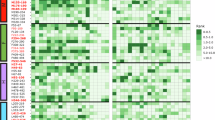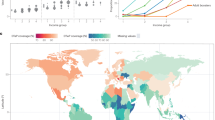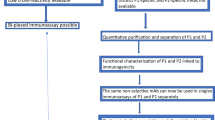Abstract
Pathogen adaptation to public health interventions such as vaccination may take tortuous routes and involve multiple mutations at different locations in the pathogen genome, acting on distinct phenotypic traits. Yet how these multi-locus adaptations jointly evolve is poorly understood. Here we consider the joint evolution of two adaptations: pathogen escape from the vaccine-induced immune response and adjustments to pathogen virulence affecting transmission or clearance. We elucidate the role played by epistasis and recombination, with an emphasis on the different protective effects of vaccination. We show that vaccines blocking infection, reducing transmission and/or increasing clearance generate positive epistasis between the vaccine-escape and virulence alleles, favouring strains that carry both mutations, whereas vaccines reducing virulence mortality generate negative epistasis, favouring strains that carry either mutation but not both. High rates of recombination can affect these predictions. If epistasis is positive, frequent recombination can prevent the transient build-up of more virulent escape strains. If epistasis is negative, frequent recombination between loci can create an evolutionary bistability, favouring whichever adaptation is more accessible. Our work provides a timely alternative to the variant-centred perspective on pathogen adaptation and captures the effect of different types of vaccine on the interference between multiple adaptive mutations.
This is a preview of subscription content, access via your institution
Access options
Access Nature and 54 other Nature Portfolio journals
Get Nature+, our best-value online-access subscription
$32.99 / 30 days
cancel any time
Subscribe to this journal
Receive 12 digital issues and online access to articles
$119.00 per year
only $9.92 per issue
Buy this article
- Purchase on SpringerLink
- Instant access to full article PDF
Prices may be subject to local taxes which are calculated during checkout




Similar content being viewed by others
Data availability
No data were used for this manuscript.
Code availability
All custom code used to generate the figures in the main text and Supplementary Information was written in MATLAB74 and is available as Supplementary Software.
References
McLean, A. R. Vaccines and their impact on the control of disease. Br. Med. Bull. 54, 545–556 (1998).
Kennedy, D. A. & Read, A. F. Why does drug resistance readily evolve but vaccine resistance does not?. Proc. R. Soc. B 284, 20162562 (2017).
Kennedy, D. A. & Read, A. F. Why the evolution of vaccine resistance is less of a concern than the evolution of drug resistance. Proc. Natl Acad. Sci. USA 115, 12878–12886 (2018).
McLean, A. R. Vaccination, evolution and changes in the efficacy of vaccines: a theoretical framework. Proc. R. Soc. B 261, 389–393 (1995).
Gupta, S., Ferguson, N. M. & Anderson, R. M. Vaccination and the population structure of antigenically diverse pathogens that exchange genetic material. Proc. R. Soc. B 264, 1435–1443 (1997).
Lipsitch, M. Vaccination against colonizing bacteria with multiple serotypes. Proc. Natl Acad. Sci. USA 94, 6571–6576 (1997).
Restif, O. & Grenfell, B. T. Vaccination and the dynamics of immune evasion. J. R. Soc. Interface 4, 143–153 (2007).
van Boven, M., Mooi, F. R., Schellekens, J. F. P., de Melker, H. E. & Kretzschmar, M. Pathogen adaptation under imperfect vaccination: implications for pertussis. Proc. R. Soc. B 272, 1617–1624 (2005).
Gandon, S., Mackinnon, M. J., Nee, S. & Read, A. F. Imperfect vaccines and the evolution of pathogen virulence. Nature 414, 751–756 (2001).
Gandon, S., Mackinnon, M., Nee, S. & Read, A. F. Imperfect vaccination: some epidemiological and evolutionary consequences. Proc. R. Soc. B 270, 1129–1136 (2003).
Andre, J. & Gandon, S. Vaccination, within-host dynamics, and virulence evolution. Evolution 60, 13–23 (2006).
Atkins, K. E. et al. Vaccination and reduced cohort duration can drive virulence evolution: Marek’s disease virus and industrialized agriculture. Evolution 67, 851–860 (2012).
Ganusov, V. V. & Antia, R. Imperfect vaccines and the evolution of pathogens causing acute infections in vertebrates. Evolution 60, 957–969 (2006).
Williams, P. D. & Day, T. Epidemiological and evolutionary consequences of targeted vaccination. Mol. Ecol. 17, 485–499 (2008).
Bernhauerová, V. Vaccine-driven evolution of parasite virulence and immune evasion in age-structured population: the case of pertussis. Theor. Ecol. 9, 431–442 (2016).
Anderson, R. M. & May, R. M. Coevolution of hosts and parasites. Parasitology 85, 411–426 (1982).
Frank, S. A. Models of parasite virulence. Q. Rev. Biol. 71, 37–78 (1996).
Alizon, S., Hurford, A., Mideo, N. & van Baalen, M. Virulence evolution and the trade-off hypothesis: history, current state of affairs and the future. J. Evol. Biol. 22, 245–259 (2009).
Cressler, C. E., McLeod, D. V., Rozins, C., van den Hoogen, J. & Day, T. The adaptive evolution of virulence: a review of theoretical predictions and empirical tests. Parasitology 143, 915–930 (2016).
Witter, R. L. Increased virulence of Marek’s disease virus field isolates. Avian Dis. 41, 149–163 (1997).
Read, A. F. et al. Imperfect vaccination can enhance the transmission of highly virulent pathogens. PLoS Biol. 13, e1002198 (2015).
Read, A. F. & Mackinnon, M. J. in Evolution in Health and Disease (eds Stearns, S. C. & Koella, J. C.) Ch. 11 (Oxford Univ. Press, 2008).
Mackinnon, M. J. & Read, A. F. Immunity promotes virulence evolution in a malaria model. PLoS Biol. 2, 1286–1292 (2004).
Barclay, V. C. et al. The evoutionary consequences of blood-stage vaccination on the rodent malaria Plasmodium chabaudi. PLoS Biol. 10, e1001368 (2012).
Mooi, F. R. et al. Bordetella pertussis strains with increased toxin production associated with pertussis resurgence. Emerg. Infect. Dis. 15, 1206–1213 (2009).
Grenfell, B. T. et al. Unifying the epidemiological and evolutionary dynamics of pathogens. Science 303, 327–323 (2004).
Saad-Roy, C. M. et al. Epidemiological and evolutionary considerations of SARS-CoV-2 vaccine dosing regimes. Science 372, 363–370 (2021).
Cobey, S., Larremore, D. B., Grad, Y. H. & Lipsitch, M. Concerns about SARS-CoV-2 evolution should not hold back efforts to expand vaccination. Nat. Rev. Immunol. https://doi.org/10.1038/s41577-021-00544-9 (2021).
Kouyos, R. D. et al. The path of least resistance: aggressive or moderate treatment? Proc. R. Soc. B 281, 20140566 (2014).
Acevedo, M. A., Dillemuth, F. P., Flick, A. J., Faldyn, M. J. & Elderd, B. D. Virulence-driven trade-offs in disease transmission: a meta-analysis. Evolution 73, 636–647 (2019).
Telenti, A. et al. After the pandemic: perspectives on the future trajectory of COVID-19. Nature 596, 495–504 (2021).
Slatkin, M. Linkage disequilibrium—understanding the evolutionary past and mapping the medical future. Nat. Rev. Genetics 9, 477–485 (2008).
Rice, S. H. Evolutionary Theory: Mathematical and Conceptual Foundations (Sinauer Associates, 2004).
Day, T. & Gandon, S. The evolutionary epidemiology of multilocus drug resistance. Evolution 66, 1582–1597 (2012).
McLeod, D. V. & Gandon, S. Understanding the evolution of multiple drug resistance in structured populations. eLife 10, e65645 (2021).
de Visser, J. A. G. M., Cooper, T. F. & Elena, S. F. The causes of epistasis. Proc. R. Soc. B 278, 3671–3624 (2011).
Felsenstein, J. The effect of linkage on directional selection. Genetics 52, 349–363 (1965).
Lewontin, R. C. & Kojima, K. The evolutionary dynamics of complex polymorphisms. Evolution 14, 458–472 (1960).
de Visser, J. A. G. M. & Elena, S. F. The evolution of sex: empirical insights into the roles of epistasis and drift. Nat. Rev. Genetics 8, 139–149 (2007).
Otto, S. P. & Barton, N. H. The evolution of recombination: removing the limits to natural selection. Genetics 147, 879–906 (1997).
Fenner, F. J. The Florey lecture, 1983—biological control, as exemplified by smallpox eradication and myxomatosis. Proc. R. Soc. B 218, 259–285 (1983).
Muñoz-Alía, M. Á., Nace, R. A., Zhang, L. & Russell, S. J. Serotypic evolution of measles virus is constrained by multiple co-dominant B cell epitopes on its surface glycoproteins. Cell Rep. Med. 2, 100225 (2021).
Kouyos, R. D., Fouchet, D. & Bonhoeffer, S. Recombination and drug resistance in HIV: population dynamics and stochasticity. Epidemics 1, 58–69 (2009).
Gandon, S. & Day, T. The evolutionary epidemiology of vaccination. J. R. Soc. Interface 4, 803–817 (2007).
Maynard Smith, J. & Haigh, J. The hitch-hiking effect of a favourable gene. Genet. Res. 23, 23–35 (1974).
Harrison, T. J., Hopes, E. A., Oon, C. J., Zanetti, A. R. & Zuckerman, A. J. Independent emergence of a vaccine-induced escape mutant of hepatitis B virus. J. Hepatology 13, S105–S107 (1991).
Mooi, F. R. et al. Polymorphism in the Bordetella pertussis virulence factors P.69/Pertactin and pertussis toxin in the Netherlands: temporal trends and evidence for vaccine-driven evolution. Infect. Immun. 66, 670–675 (1998).
Gandon, S. & Day, T. Evidences of parasite evolution after vaccination. Vaccine 26, C4–C7 (2008).
Pica, N. & Palese, P. Toward a universal influenza virus vaccine: prospects and challenges. Annu. Rev. Med. 64, 189–202 (2013).
Pardi, N., Hogan, M. J., Porter, F. W. & Weissman, D. mRNA vaccines—a new era in vaccinology. Nat. Rev. Drug Discov. 17, 261–279 (2018).
Subramanian, R., Graham, A. L., Grenfell, B. T. & Arinaminpathy, N. Universal or specific? A modeling-based comparison of broad-spectrum influenza vaccines against conventional, strain-matched vaccines. PLoS Comput. Biol. 12, e1005204 (2016).
Viboud, C. et al. Beyond clinical trials: evolutionary and epidemiological considerations for development of a universal influenza vaccine. PLoS Pathog. 16, e1008583 (2020).
Arinaminpathy, N. et al. Impact of cross-protective vaccines on epidemiological and evolutionary dynamics of influenza. Proc. Natl Acad. Sci. USA 109, 3173–3177 (2012).
Saad-Roy, C. M., McDermott, A. B. & Grenfell, B. T. Dynamic perspectives on the search for a universal influenza vaccine. J. Infect. Dis. 219, S46–S56 (2019).
Arinaminpathy, N., Riley, S., Barclay, W. S., Saad-Roy, C. & Grenfell, B. Population implications of the deployment of novel universal vaccines against epidemic and pandemic influenza. J. R. Soc. Interface 17, 20190879 (2020).
Ekiert, D. C. et al. Antibody recognition of a highly conserved influenza virus epitope. Science 324, 246–251 (2009).
Epstein, S. L. & Price, G. E. Cross-protective immunity to influenza A viruses. Expert Rev. Vaccines 9, 1325–1341 (2010).
Yurkovetskiy, L. et al. Structural and functional analysis of the D614G SARS-CoV-2 spike protein variant. Cell 183, 739–751.e8 (2020).
Ozono, S. et al. SARS-CoV-2 D614G spike mutation increases entry efficiency with enhanced ACE2-binding affinity. Nat. Commun. 12, 848 (2021).
Jangra, S. et al. SARS-CoV-2 spike E484K mutation reduces antibody neutralisation. Lancet Microbe 2, E283–E284 (2021).
Greaney, A. J. et al. Mutational escape from the polyclonal antibody response to SARS-CoV-2 infection is largely shaped by a single class of antibodies. bioRxiv https://doi.org/10.1101/2021.03.17.435863 (2021).
Peck, K. M., Burch, C. L., Heise, M. T. & Baric, R. S. Coronavirus host range expansion and Middle East respiratory syndrome coronavirus emergence: biochemical mechanisms and evolutionary perspectives. Annu. Rev. Virol. 2, 95–117 (2015).
Jackson, B. et al. Generation and transmission of inter-lineage recombinants in the SARS-CoV-2 pandemic. Cell https://doi.org/10.1016/j.cell.2021.08.014 (2021).
Turkahia, Y. Pandemic-scale phylogenomics reveals elevated recombination rates in the SARS-CoV-2 spike region. bioRxiv https://doi.org/10.1101/2021.08.04.455157 (2021).
VanInsberghe, D., Neish, A. S., Lowen, A. C. & Koelle, K. Recombinant SARS-CoV-2 genomes circulated at low levels over the first year of the pandemic. Virus Evol. https://doi.org/10.1093/ve/veab059 (2021).
Can we predict the limits of SARS-CoV-2 variants and their phenotypic consequences? (UK SAGE, 2021); https://assets.publishing.service.gov.uk/government/uploads/system/uploads/attachment_data/file/1007566/S1335_Long_term_evolution_of_SARS-CoV-2.pdf
Polack, F. P. et al. Safety and efficacy of the BNT162b2 mRNA Covid-19 vaccine. N. Engl. J. Med. 383, 2603–2615 (2020).
Dagan, N. BNT162b2 mRNA Covid-19 vaccine in a nationwide mass vaccination setting. N. Engl. J. Med. 384, 1412–1423 (2021).
Regev-Yochay, G. et al. Decreased infectivity following BNT162b2 vaccination: a prospective cohort study in Israel. Lancet Reg. Health Eur. 7, 100150 (2021).
Ke, R. et al. Longitudinal analysis of SARS-CoV-2 vaccine breakthrough infections reveal limited infectious virus shedding and restricted tissue distribution. medRxiv https://doi.org/10.1101/2021.08.30.21262701 (2021).
Thompson, M. G. et al. Prevention and attenuation of Covid-19 with the BNT162b2 and mRNA-1273 vaccines. N. Engl. J. Med. 385, 320–329 (2021).
Baker, R. E. et al. The impact of COVID-19 nonpharmaceutical interventions on the future dynamics of endemic infections. Proc. Natl Acad. Sci. USA 117, 30547–30553 (2020).
Gandon, S. & Lion, S. Targeted vaccination and the speed of SARS-CoV-2 adaptation. Proc. Natl Acad. Sci. USA 119, e2110666119 (2022).
MATLAB v. 9.6.0 (R2019a) (The MathWorks Inc., 2019).
Acknowledgements
This work was supported by a NSERC-CRSNG postdoctoral fellowship to D.V.M. S.G. acknowledges financial support from the CNRS and from Agence Nationale de la Recherche (ANR-17-CE35-0012).
Author information
Authors and Affiliations
Contributions
D.V.M. and S.G. formulated the research question, designed and analysed the model and wrote the manuscript.
Corresponding authors
Ethics declarations
Competing interests
The authors declare no competing interests.
Peer review
Peer review information
Nature Ecology & Evolution thanks Ana Bento and the other, anonymous, reviewer(s) for their contribution to the peer review of this work.
Additional information
Publisher’s note Springer Nature remains neutral with regard to jurisdictional claims in published maps and institutional affiliations.
Supplementary information
Supplementary Information
Supplementary Discussion 1–10 and Figs. 1–6.
Supplementary Software
All custom code to make figures featured in main text and supplementary information.
Rights and permissions
About this article
Cite this article
McLeod, D.V., Gandon, S. Effects of epistasis and recombination between vaccine-escape and virulence alleles on the dynamics of pathogen adaptation. Nat Ecol Evol 6, 786–793 (2022). https://doi.org/10.1038/s41559-022-01709-y
Received:
Accepted:
Published:
Issue date:
DOI: https://doi.org/10.1038/s41559-022-01709-y
This article is cited by
-
Exciting times for evolutionary biology
Nature Ecology & Evolution (2024)
-
Contribution of host species and pathogen clade to snake fungal disease hotspots in Europe
Communications Biology (2024)
-
Integrating Genomic Data with the Development of CRISPR-Based Point-of-Care-Testing for Bacterial Infections
Current Clinical Microbiology Reports (2024)
-
Consequences of Genetic Recombination on Protein Folding Stability
Journal of Molecular Evolution (2023)
-
Adapting to vaccination
Nature Ecology & Evolution (2022)



